Affiliate Link Disclaimer Examples & Best Practices
Are you using affiliate links on your blog or social media, and you want to make sure that you’re complying with the FTC regulations and adding your affiliate marketing disclaimers in the right places? This post will show you how to properly disclose your affiliate links, and if you don’t know how to phrase yours, you can also download my examples and my free affiliate disclosure template below.
I assume that, since you are reading this post, you already know what affiliate marketing is and you simply want to take the legal precautions to protect yourself and your blog and comply to the requirements of the affiliate programs that you’re a part of.
If that’s not the case and you want to know more about affiliate marketing, start with reading these posts first:
Or if you’re brand new and still struggling to get started and make your first sale, you can take my free video course on How To Make Your First Affiliate Sale.
This 5-day course will guide you through the principles of what makes a good affiliate marketing campaign and will arm you with the tools and resources you’ll need to monetize your blog without coming across as salesly to your readers. Enroll here!
Now that you’re familiar with what affiliate marketing is and how you use it, you’re probably aware that with every affiliate link must come with an affiliate disclosure or disclaimer.
Disclaimer + example: This post contains affiliate links. This means I may earn a commission should you chose to sign up for a program or make a purchase using my link. It’s okay – I love all of these companies anyways, and you will too!
What is an affiliate disclosure?
An affiliate disclosure is a statement that lets your readers or followers know when affiliate links are being used on your blog or on any other platform.
Ideally, a good affiliate disclosure should clue your readers in on the fact that you have something to gain from recommending a certain product or brand, so that they can get a full overview of what your intentions might be. In this case, it’s only ethical to let your readers know that when they purchase something through your links, you get awarded a commission for that purchase.
Why do I need to disclose my affiliate links?
As I said, whenever you use an affiliate link, you must also add an affiliate disclosure. And here is why:
- YOU’RE LEGALLY REQUIRED TO. I’m going to start with the scary legal requirements first, because yes, it is required by law to let your audience know that you have something to gain based on the recommendations you make.
The law that enforces this practice is carried out by the FTC, and while no one is going to sue you if you forget to add an affiliate disclosure somewhere, you might want to familiarize yourself with the practices of disclosing properly and steer clear of any legal backlash.
In 2017 alone, the FTC sent cease and desist letters to Instagram celebrities who were partnering with brands and reprimanded YouTubers with gaming channels who were endorsing gambling companies—all without appropriate disclosure. (source)
I’m going to over what that actually means further along in this post, but I highly recommending reading this FAQ guide released by the FTC if you have further questions about how to comply legally, or if you have a unique situation and want a specific answer.
The post also addresses disclosing practices for working with brands on sponsored posts and other types of connections between advertisers and endorsers, so it might be useful if you monetize your blog that way as well.
- YOU’LL GET YOUR READERS TO TRUST YOU MORE. Most internet-savvy people will be able to recognize affiliate links without you pointing them out, and other people will assume that you have some something to gain from endorsing a certain product/course/company anyways.
A lot of new affiliate marketers are afraid to disclose their links because they think it will turn people away and that they will miss out on clicks and sales. But I think it’s quite the contrary!
Instead of losing your audience’s trust because you decided to sneak around and hide your affiliate links, why not be honest and transparent with your readers (that probably already know the truth)? This way, you get to build on your connection with them, and you don’t risk being tossed out of your affiliate programs either.
Just like sponsored posts, where you get paid to review an item for example, the fact that you have a monetary gain from promoting a certain product or service, should be known to your readers so they can have a full picture on your relationship with the brand you’re advertising.
By remaining honest and transparent, you’re able to breach the skepticism around this topic and admit that, yes, you might get paid if they make a purchase, but that you would recommend that product or service anyways. Or at least, you should.
If you’re promoting something and you’re not comfortable disclosing (that you’re using an affiliate link), you probably shouldn’t be talking about that product or service in the first place, and I suggest you reconsider your affiliate strategy.
I personally believe that we should be true fans of the things we choose to endorse on our platforms, not only because that’s morally correct, but because that will show up in how we promote it, and our readers pick up on that. In other words, people can usually tell if you’re genuine or not about a product, and if you truly believe in it, they will have no problem using your affiliate link to buy it.
(In fact, I came across cases where people intentionally used my affiliate links as a “thank you” for recommending them a product that they loved, and that should be your goal as an affiliate marketer.)
📌 PIN THIS POST FOR LATER
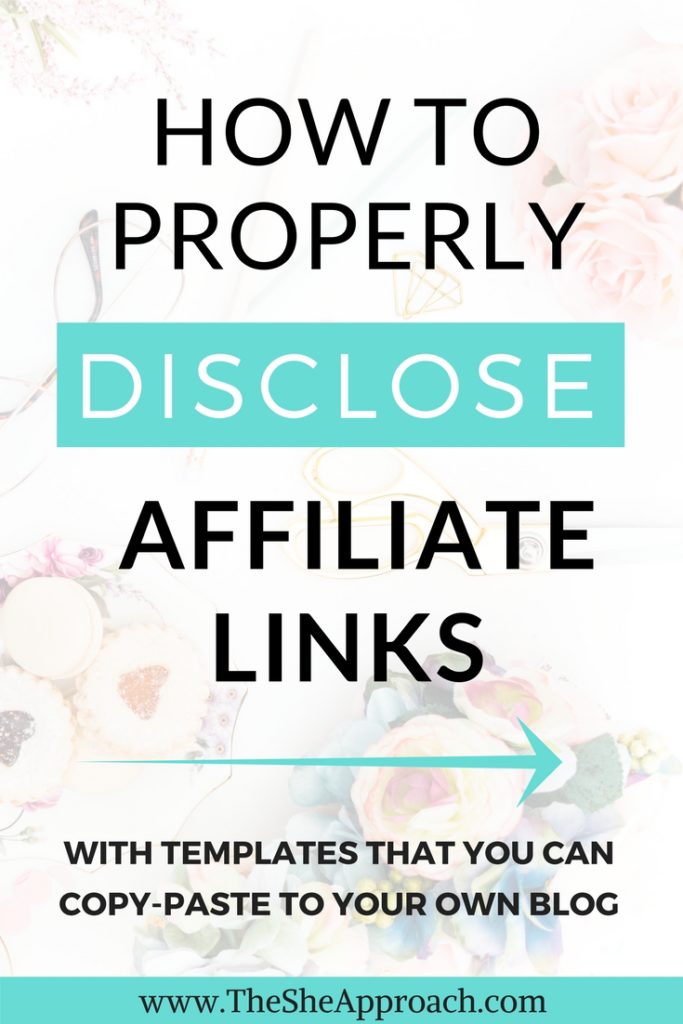
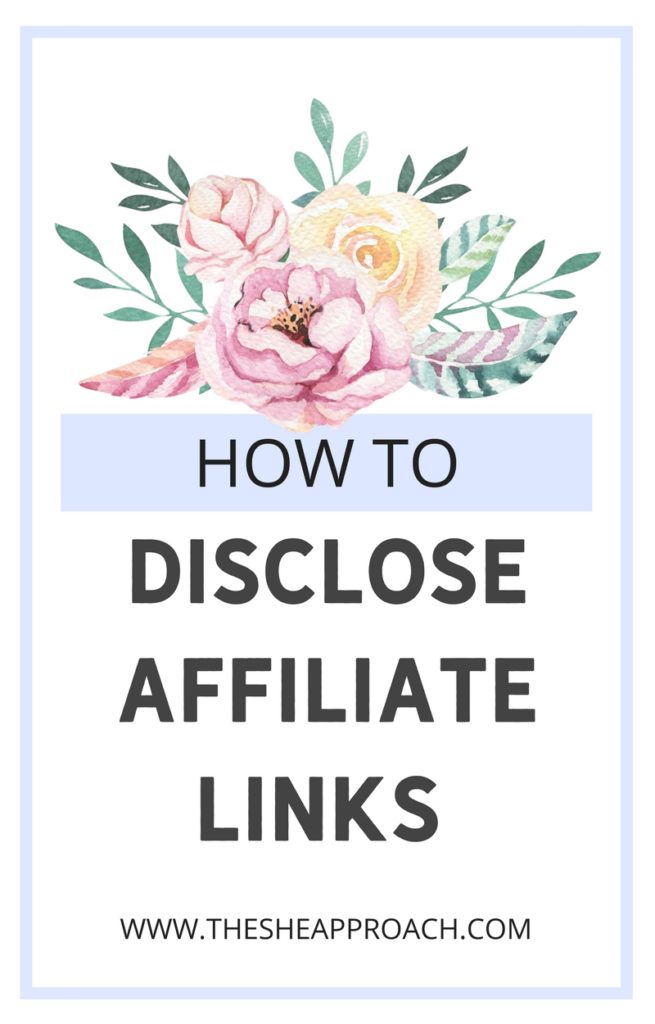
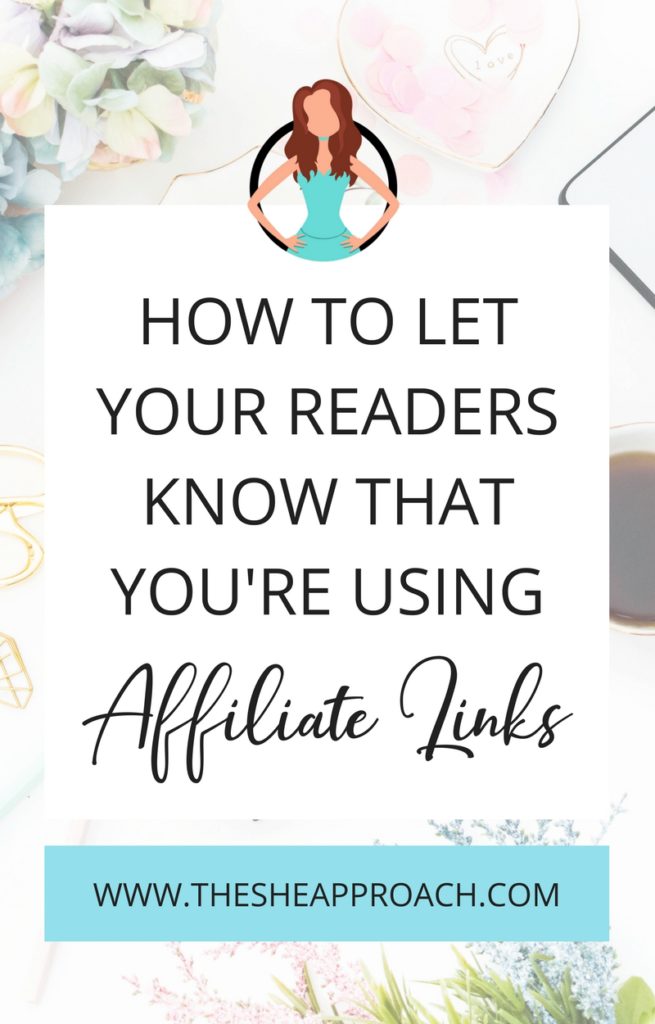
How do you properly disclose your affiliate links?
And now, the fun part! Believe it or not, there is a right and wrong way to disclose your affiliate links, and that mostly has to do with how you phrase your affiliate disclosure and where you place it.
If you’re just now writing an affiliate disclosure template for your own website, take note of the suggestions below and model your approach to these tips.
But if you already attempted to disclose your affiliate links in the past, take a look at the notes below and compare them to your existing approach, to make sure you’ve done it correctly.
Also, keep in mind that these rules mostly apply to disclosing affiliate links in big chunks of content such as blog posts or emails. When it comes to social media, because of the limited amount of characters, disclosures such as “This is an affiliate link.” or “#affiliatelink” are accepted.
HOW TO PHRASE YOUR AFFILIATE DISCLOSURES
According to FTC regulations your affiliate disclosure needs to be “clear and conspicuous”. That means you need to use clear language, that your readers can understand even if they are not familiar with how affiliate marketing works and you need to state that you’re earning a commission for the sales made through your links.
The idea here is to stop beating around the bush in order to confuse your readers. Using jargon is not acceptable either because your readers might not understand a simple statement such as “This is an affiliate link.” if they are not familiar with what affiliate marketing is.
That doesn’t mean that your affiliate disclosure needs to sound like something out of a legal textbook, but it needs to be understood by your readers and it needs to disclose your affiliation with the products or services you endorse.
In fact, the FTC press release states that: “Advertisers have the flexibility to be creative in designing their ads, as long as the necessary information is communicated effectively and the overall message conveyed to consumers is not misleading.”
So you are free to write your affiliate disclaimer in your own words, as long as it follows these rules. Some people use their disclaimers as a forte, communicating how strongly they believe in what they are endorsing, thus turning a legal statement into a selling point.
Copy Blogger has a great article about how you can turn your disclosures into selling points that I highly recommend reading, where he talks about delivering your affiliate links with confidence, which is a great tactic!
NOTE: Keep in mind that some affiliate programs have specific requirements that you should take into consideration when you disclaim their affiliate links. Amazon, for example, have pretty strict rules and forbid you from incentivizing your followers to use your links.
So you can’t say “using my affiliate link supports my blog” or anything that can sound like asking for an affiliate sale.
You can read the Amazon Affiliate Agreement here for further info.
But a good example of an Amazon-approved disclosure if you use Amazon affiliate links is “As an Amazon Associate I earn from qualifying purchases.”.
You also need to keep in mind that if you’re promoting a product or service and speaking about the results you got out of using that, you need to make it obvious to your readers that you’re showcasing your own experience.
FTC explains this point further: “Testimonials claiming specific results usually will be interpreted to mean that the endorser’s experience reflects what others can also expect. That leaves advertisers with two choices:
- Have adequate proof to back up the claim that the results shown in the ad are typical, or
- Clearly and conspicuously disclose the generally expected performance in the circumstances shown in the ad.”
Tailwind for example, whose affiliate program I am in, sent out an email asking their affiliates to link to a case study where they show collected data of what new customers can expect when using their service (in terms of numbers), in order to make sure that their affiliates are FCT compliant.
So be sure to check out the guidelines of all the Affiliate Programs you join, to see if there are any special rules you need to comply with, and respect those to avoid any trouble with the affiliate programs or with the FTC.
If you want to see some of my favorite examples of practical affiliate links with a touch of personality, and if you are in need of a few templates that you can copy-paste at your own will, download my cheat sheet below:
Pat Flynn has a dedicated Affiliate Disclosure page that is beautifully phrased, that’s worth checking out for inspiration as well.

And if you’re still struggling with phrasing your own disclaimer using the templates in this post, I highly recommend investing in a paid affiliate disclosure template written by an actual lawyer.
WHERE TO PLACE YOUR AFFILIATE LINK DISCLOSURES
Now, believe it or not, most bloggers do pretty well in the “phrasing the affiliate disclosure correctly” department, but they fail to place the disclosures in the right places, thus, still breaking the FTC regulations, according to which “A disclosure is more effective if it is placed near the claim it qualifies or other relevant information. “
Then go on to say that “If scrolling is necessary to view a disclosure, then, ideally, the disclosure should be unavoidable — consumers should not be able to proceed further with a transaction, e.g., click forward, without scrolling through the disclosure. “
In plain language, here is where you should place your affiliate disclosure:
- Before any affiliate links are added. This is extremely relevant for blog posts and online articles in particular, where you want to have your disclosure somewhere at the beginning of the post. I usually like to add mine after the introductory paragraph, but a lot of bloggers place it right after their featured photo. The idea here is to let people know that you’re using affiliate links in that post, before they read the post. Simple, right?
- On the same page as your affiliate links and in close proximity. This means that you shouldn’t ask people to click on a different page to read your disclaimer or add it somewhere irrelevant and hidden. I also include a quick affiliate disclaimer in my sidebar, to cover all grounds. The idea here is to stop trying to hide your disclosure and to place it as close as possible to your actual affiliate links.
- In plain sight. Again, don’t try to be sneaky and add your affiliate disclosure in places that are hard to reach or read. (Aka don’t use a white, ant-sized font that’s hidden in the code of a picture.) If your grandpa can’t find it after scrolling through your blog post once, you’re doing it wrong!
And that concludes my highly-researched opinion on how you should be using your affiliate disclaimers. When you come to think about it, it’s not that hard, or that scary, so if you’ve been using affiliate links on your blog, start putting it off, and craft your own affiliate disclosure today!
You can use the tips above, or enter your email address below, and I’ll send over a few affiliate disclaimers examples that you can copy-paste, or use them as templates to write the perfect affiliate disclosure – in your own voice.
Disclosing Affiliate Links On Social Media
When it comes to sharing affiliate links on social media, the rules are a little more simple due to the constraint of characters that we face – especially on platforms like Twitter or Instagram stories for example.
Social media descriptions are not known for long-form content, so the FTC doesn’t expect you to use a full affiliate disclaimer, as you would on your blog, in a 260 characters tweet, for example.
Using a hashtag like #affiliatelink, #ad or #sponsored (usually used for sponsored posts) or simply writing “This is an affiliate link” will do. But once again, these need to be clearly visible and not hidden between 29 other hashtags somewhere at the bottom.
However, the FTC concluded that the shortened hashtags #aff and #spon should not be used as most consumers are not aware of their meaning.
Examples of Affiliate Disclaimers on YouTube
YouTube is an awesome tool for content creators that use affiliate marketing because it’s one of the biggest search engines in the world. Every single day, 30 million people visit YouTube and over 300 hours worth of video are uploaded every minute.
With numbers like that, it’s easy to see why you want to include YouTube videos in your affiliate marketing strategy.
But if you’re planning on recommending products you’re affiliated with through them you need to include an affiliate disclaimer. Without one, you can run into some major headaches.
When it comes to disclosing affiliate links on Youtube or Instagram, you’re required to disclose them in the same format that you share the link.
If you share an affiliate link in a Youtube video, you need to mention it verbally while on camera, and if you add links to the description, you need to add it in writing too. (Something like “This video contains affiliate links. If you click on one of them, and make a purchase I’ll receive a commission.“)
The reason for that is because Youtube videos can be shared and embedded in various places where the description box doesn’t show – so if you send people to a custom link in the actual video, they won’t see the disclaimer that it’s an affiliate link.
A great way around this is by using the “”Paid Product Placement” box that Youtube provides. The next time you upload a video with affiliate links, head over to the Advanced tab and check the box that says “This video contains paid promotion such as paid product placement, sponsorships or endorsement.”
So if you add a swipe-up to an Instagram story, you need to either mention it in the video or add the hashtag #affiliatelink or #ad visibly in that same story.
But before you’re off to make that happen, please keep in mind that this article is intended to be a general resource only and does not constitute legal advice. I am not a lawyer nor do I claim any certified expertise in this area.
If you’re looking for a professional & 100% bulletproof disclaimer, I highly recommend investing in this affiliate disclosure template written by a qualified lawyer.
My recommendations are based on personal opinion and research, but I highly recommend checking out the references I made through this blog post and read more in-depth about the FTC laws.
And P.S. – if you’re a blogger outside of the US, still look to respect the FTC laws and don’t just think that their guidelines don’t apply to you because you live in another country.
According to the FTC’s What People Are Asking page, if American consumers will are likely to click on your affiliate links or if the products you’re promoting are sold in the US then you’re responsible for creating a proper affiliate disclaimer. Plus, as the FTC points out, the UK and several other countries have similar disclaimer guidelines. So better save than sorry.
WHAT TO READ NEXT & MORE RESOURCES:
- Free Legal Course For Bloggers
- Full legal bundle for bloggers with FTC+GDPR+CCPA compliant templates (highly recommend it – use the code FLASHSALE30 to get 30% off before June 1st)
- How To Become An Etsy Affiliate
- How To Make Money From Your Blog As An Amazon Affiliate
- How I Made My First $25,000 Blogging
- 3 Ways Bloggers Can Make Money With Send Owl
- Blogging Income Tracker Template
Article Last Updated: February 2021
How To Properly Disclose Your Affiliate Links + Free Affiliate Disclaimer Template And Examples
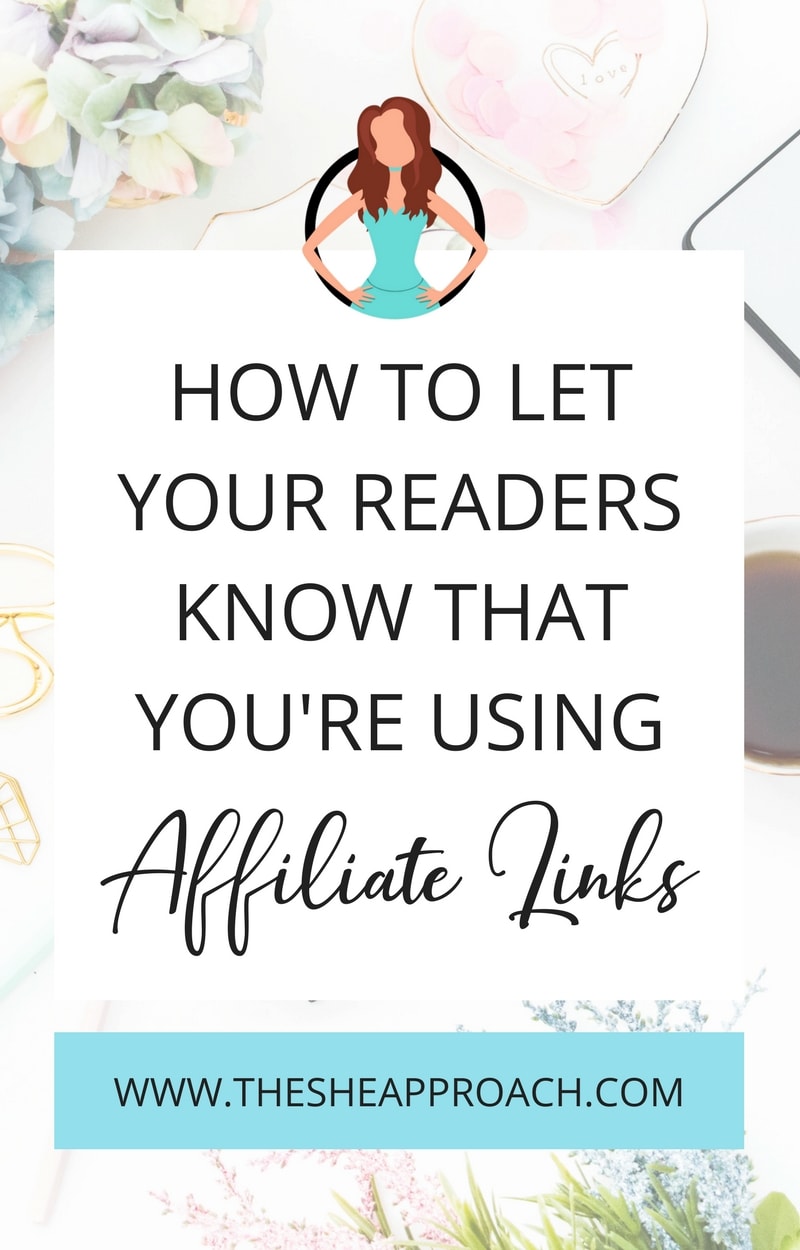
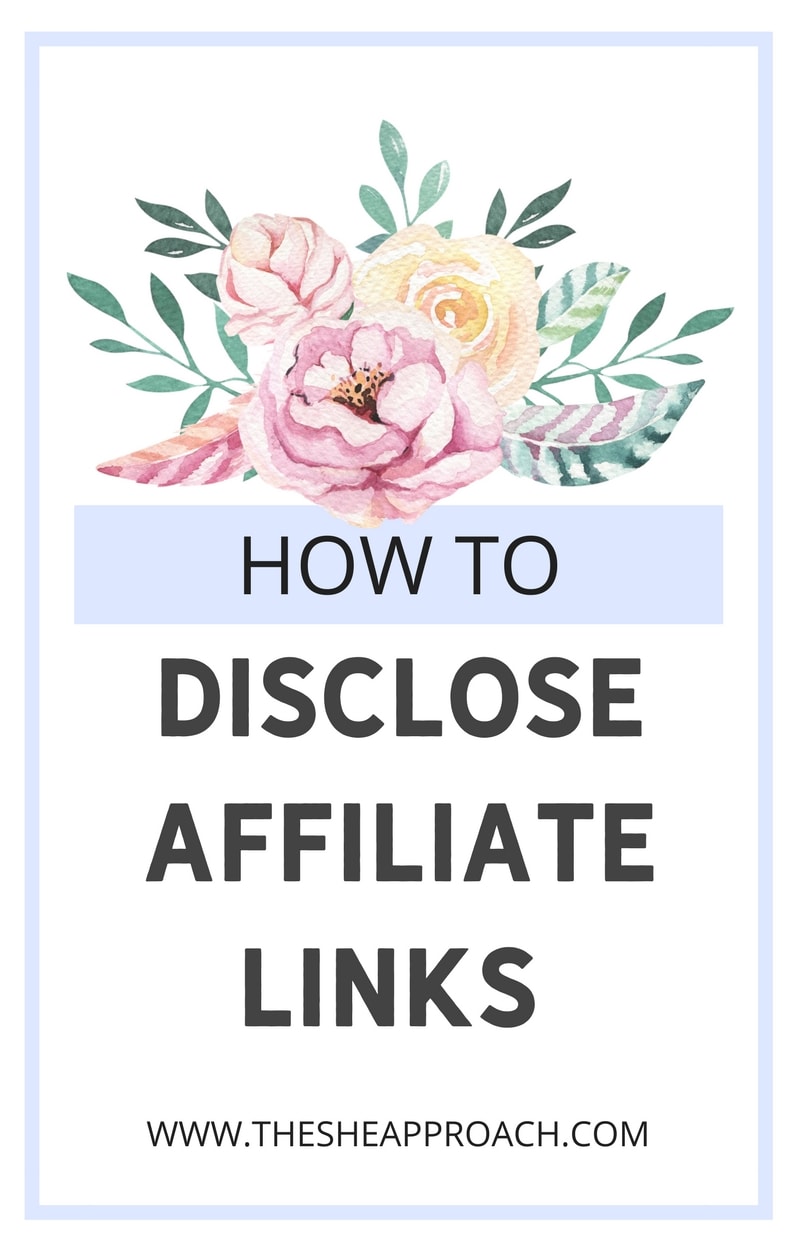
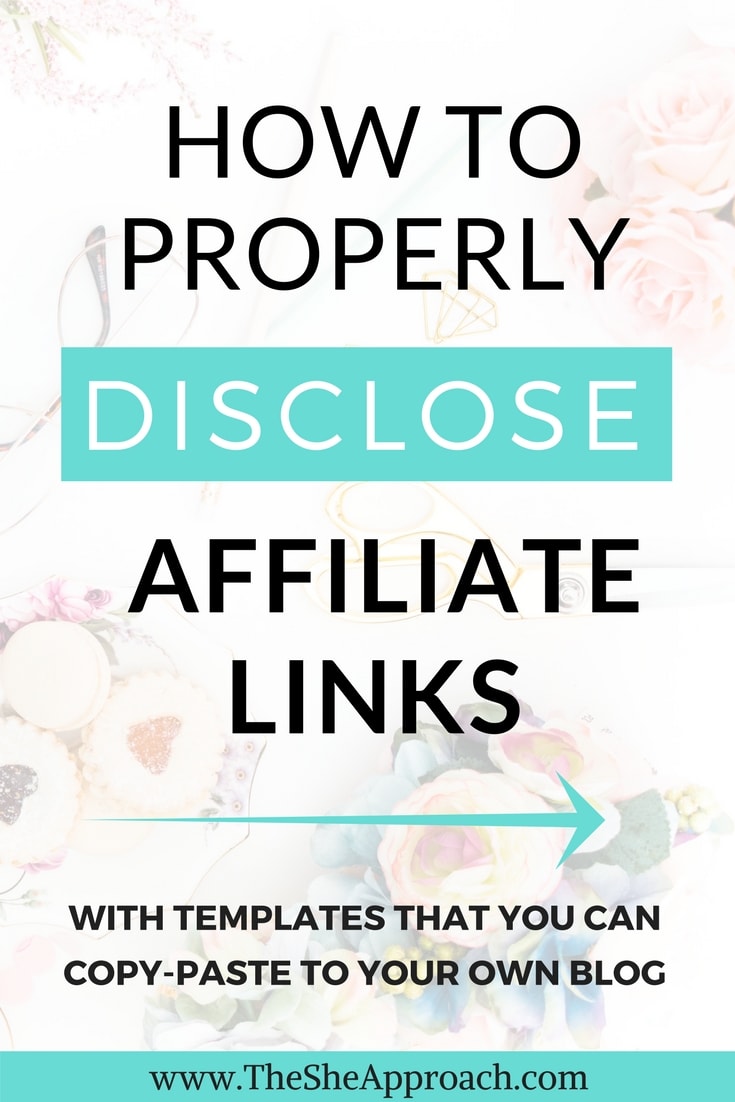














This was super helpful, thanks Ana!
This is so awesome. I love the tips that you have given. Now I know how to properly disclose it on my upcoming blog.
Happy to help!
Transparency really is key when it comes to conflicts of interest, which includes advertisements, sponsors, or affiliate links. I’ve found showing the privacy or advertisement notice up front, clearly, is most conducive to maintaining a high level of trust with readers without diminishing the quality of the content. Thanks for a superb post on the topic, Ana!
https://rhyskeller.com
This is a great article about disclosing affiliate links on your pages and posts but noticed you have not disclosed them on this page. Did I miss the disclosure on this page?
Hi Sam. Yes, there is a disclosure at the top – made the background blue so it stands out more – and one in the sidebar as well. Glad this post was useful!
Good content on How To Properly Disclose Your Affiliate Links + Free Affiliate Disclosure Template. Helpful
Hey Ana, I am completely broke and don’t know from where to start my Amazon Affiliate journey. They is so much on Amazon’s website and I am not able to understand any thing like Responsive banners, Text+Image link, etc.
Could you please make a video on every section of Amazon Affiliate Tools and how to use them?
I watch videos but at the end I am not able to figure out from where and how to start!
Please advice.
Regards,
Sanket
Heya – I have a very simple tutorial here that shows you how to grab links and images – that’s really all you need – https://youtu.be/bTGMWHL4K-k.
Could you just place the disclaimer “globally” at the foot of your site alongside the Copyright notice, instead of putting it in every post every time you create a new post? That way it will always appear at the bottom regardless.
Yes – but FTC regulations still require you to post a short disclaminer before or in close proximity to your links (not just hidden away at the end).